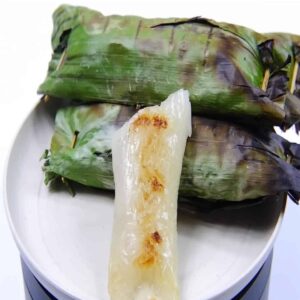Each home chef brings forgotten flavours and new ways of looking at the cuisine of a region to our tables. Hoihnu Hauzel is no exception. An independent journalist and the curator of the website NorthEastOdyssey.com, Hoihnu of We The Chefs has the distinction of writing the first cookbook dedicated to India’s North-East, and she addressed the widely held misconceptions about the region on ‘Food Talk with Sourish’.
For starters, Hoihnu Hauzel made it abundantly clear that the North-East cannot be lumped together as one homogeneous region tucked away in one corner of the country, as we often tend to do. It is a mosaic of communities, each with its own history and traditions, as well as religious and cultural practices. Arunachal Pradesh, for instance, has more than a hundred distinct tribes; in Meghalaya, the people living in the Khasi, Garo and Jaintia hills have their own identities and are proud of being the way they are; and in Hoihnu’s native Manipur, those living in the plains are very different from the ones in the hills.
The different ethnicities and cultures can be multiplied as one travels through the eight north-eastern states, also known as the Seven Sisters (Arunachal Pradesh, Assam, Manipur, Meghalaya, Mizoram, Nagaland and Tripura) and One Brother (Sikkim). What binds them together, though, is their love for rice and pork, and the extensive use of bamboo shoots (fermented or otherwise) in their cuisines. More importantly, it is the simplicity of the cooking styles popular in the communities of the North-East that makes their cuisines stand out.
“Our food is reflective of our simplicity: you get what you see,” Hoihnu said as she talked about the ability of north-eastern communities to extract maximum flavours out of minimal cooking. Using just ginger and garlic, and sometimes turmeric (Meghalaya’s Lakadong turmeric, in fact, has a GI tag because it has the highest curcumin content among all Indian varieties), and refraining from any overuse of masalas, north-eastern communities have perfected the technique of making food taste good without invasive cooking. This flavourful simplicity was evident in all its glory in the refreshing soupy dish that Hoihnu had prepared with pumpkin, the vegetable, as well as the leaves and flowers she had plucked out from the plant growing in her backyard.

Talking about Manipur, Hoihnu mentioned the vegetable markets in her state, which she described as “medical stores”. She cited the examples of a variety of chives that is beneficial for people with high blood pressure, or Brahmi leaves, which are recommended by Ayurveda to improve memory and cognition, available across Manipur’s vegetable markets. Even passion fruit leaves come loaded with vitamins – Manipur, incidentally, is a leading producer of passion fruit (as it is of pomelo). Hoihnu added jokingly that the prices of the chives went through the roof the moment people got to know about the goodness they brought to the table. She also mentioned how most people in Manipur have pomelos growing in their gardens – and it is common for them to unwind after lunch eating the fruit spiked with a little salt and red chilli powder till the sun is ready to set.
Manipur, according to Hoihnu, has three distinct types of cooking traditions. The Meitei people in the plains (predominantly Imphal), who are mainly Vaishhavas, do not venture beyond fish and vegetables, and the Brahmins there are famous for their evolved cuisine; the communities living in the hills, such as the Paites, are not constricted by their faith – they are mainly Christian and live mostly in Churachandpur – and therefore eat meats more freely; and then there are the Tangkhuls in the Ukhrul district, who slow cook pork a clay pot known locally as ‘hampai’.
While on the subject of cooking techniques, Hoihnu dwelt upon the bamboo stem, which is employed to cook sticky rice and pork packed into its hollow part – the stem imparts a distinctive flavour to the dish being cooked inside. As she pointed out, a variety of cooking techniques – from slow cooking and smoking meats to fermentation and foraging – are used in Manipur to extract maximum flavours. Historically, necessity dictated the choice of cooking methods; today, these have become fashion statements because of celebrated international restaurants such as the late Noma. “We started out with these techniques; we had them all,” Hoihnu said.
So, what should one order from We The Chefs if one gets into the mood for some Manipuri food? Hoihnu’s favourites are pork cooked with bamboo shoots (which she gets fresh in Delhi’s INA Market) and balls made with the state’s famous black sticky rice (‘chak hao’), filled with a paste of grated coconut and jaggery.
Sharing a bottle of kiwi wine made by a friend of hers in Arunachal Pradesh, Hoihnu highlighted the North-East’s culinary diversity by gifting a pack of Urlong tea sourced from a garden located at 4,800 feet in Meghalaya’s East Khasi Hills. And she shared the inspiring story behind the tea.
It started with a school teacher who had been posted to Urlong village having to find a solution to low attendance. The teacher found out that most residents of the village were busy making alcoholic brews at home, getting drunk every night, engaging in brawls, and making their children staying at home to complete household chores. To get the children coming to school, the teacher had to get the villagers off their addiction, so he promoted the idea of planting tea and changing their lives. The villagers soon found an addiction stronger than alcohol – namely, the money and respectability that came to them as tea producers. And as their lives changed for the better, they could afford to spare their children and send them to school.
The North-East has so much to offer to tantalise our taste buds – and in this delicious diversity lie gems that are being discovered and shared by culinary sherpas such as Hoihnu. And it is people like her who make sure that the larder of We The Chefs never runs out of surprises.

